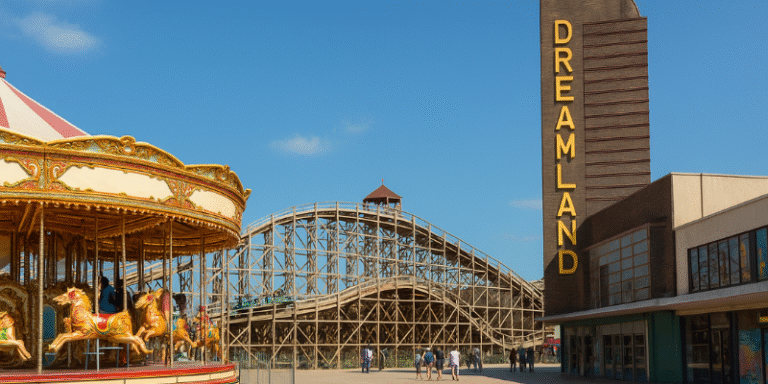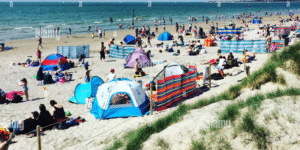On the Kent coast, the town of Margate is home to one of Britain’s most iconic seaside attractions: Dreamland Amusement Park. First opened in 1920, Dreamland is renowned for combining vintage rides with modern entertainment, embodying both the nostalgia of the traditional British seaside holiday and the dynamism of contemporary leisure culture (Wood, 2017). Its story is one of decline, rescue, and revival, reflecting wider trends in the heritage tourism sector, where historic attractions are reimagined for today’s visitors (Chapman & Light, 2011).
This article explores Dreamland’s enduring appeal, its role in cultural regeneration, and why it continues to draw both holidaymakers and heritage tourists from across the UK and beyond.
A Century of Seaside Thrills
Dreamland was originally developed on the site of the Hall by the Sea, later transforming into a full-scale amusement park in 1920. From the outset, it epitomised the pleasure culture of the British seaside, attracting visitors with rides, cinemas, dance halls, and spectacular rollercoasters (Kane, 2016). The park’s most famous attraction remains the Scenic Railway, the UK’s oldest surviving wooden rollercoaster, first built in 1920 and now a Grade II listed structure* (Brodie & Bowdler, 2017).
During the interwar years and the post-war holiday boom, Dreamland became synonymous with family fun, thrill-seeking rides, and the spirit of the Great British seaside (Wood, 2017). However, like many coastal resorts, the park experienced decline in the late 20th century as cheap overseas travel drew tourists away (Kennell, 2011).
Decline and Rescue
By the 1990s, Dreamland faced closure, neglect, and dereliction. Yet its significance as a site of cultural heritage led to grassroots campaigns to save it. The Dreamland Trust, a community-led initiative, played a key role in lobbying for its protection, securing funding, and promoting the vision of Dreamland as the world’s first Heritage Amusement Park (Laister, 2017).
This process reflected a wider trend in the “heritagisation” of leisure spaces, where cultural and social value is placed on preserving amusement parks as living museums of popular culture (Chapman & Light, 2011). After years of effort, Dreamland officially reopened in 2015 with restored vintage rides alongside modern attractions, symbolising the successful fusion of past and present.
Dreamland Today: Nostalgia Meets Modernity
The modern Dreamland offers a unique mix of retro rides and contemporary entertainment. Visitors can experience heritage attractions such as the Scenic Railway, restored Victorian amusements, and traditional funfair games, while also enjoying modern thrill rides, live music events, street food markets, and immersive art installations (Smart Life Skills, 2023).
This blend of vintage charm and modern thrills positions Dreamland as more than an amusement park: it is a cultural destination. According to Chapman (2013), the revival of seaside amusement parks like Dreamland demonstrates how heritage can be used as a tool for economic regeneration while maintaining their historic identity.
Tourism and Cultural Regeneration
Dreamland’s revival has been closely tied to Margate’s broader cultural renaissance. Alongside the Turner Contemporary gallery, Dreamland has helped reposition Margate as a tourism hotspot, attracting both domestic visitors and international travellers (Light & Chapman, 2022).
Heritage tourism literature highlights how attractions like Dreamland function as both nostalgic experiences and drivers of regeneration, creating economic opportunities and reinforcing local identity (Kennell, 2011; Wood, 2017). The park now contributes to Thanet’s visitor economy by offering family attractions, nightlife events, and cultural programming that extend the traditional tourist season.
Why Dreamland Appeals to Today’s Tourists
- Nostalgia – For older generations, Dreamland represents cherished memories of childhood holidays, evoking the golden age of seaside leisure (Chapman & Light, 2017).
- Family Entertainment – The park remains an affordable, family-friendly destination, with rides and amusements suitable for all ages.
- Cultural Experiences – Dreamland hosts music festivals, cinema screenings, and art exhibitions, catering to modern cultural consumers.
- Heritage Value – The designation of the Scenic Railway and other rides as heritage assets makes the park appealing for heritage tourists (Brodie & Bowdler, 2017).
- Community Spirit – Dreamland’s survival is tied to grassroots activism, which adds authenticity and local pride to the visitor experience (Laister, 2017).
Dreamland in the Wider Seaside Heritage Context
Dreamland is not just a local story but part of a national debate about the future of seaside resorts. According to Kane (2015), amusement parks represent an important part of Britain’s architectural and social heritage, embodying ideas of leisure, modernity, and escape. Their decline mirrored that of the British seaside itself, while their revival shows how heritage tourism can revitalise struggling resorts.
Ball (2018) argues that the photographic and cultural representation of Dreamland plays a vital role in branding Margate as a regenerated seaside town. This dual function—both as an entertainment venue and a heritage attraction—ensures Dreamland remains central to Britain’s seaside tourism identity.
Dreamland Amusement Park is more than a funfair—it is a living heritage site, a cultural landmark, and a driver of regeneration. Its survival demonstrates the enduring appeal of seaside nostalgia, while its reinvention ensures it remains relevant to 21st-century tourists. With its vintage rides and modern thrills, Dreamland continues to attract visitors of all ages, contributing to Margate’s reputation as a dynamic seaside destination.
In many ways, Dreamland is a metaphor for the British seaside itself: a place where history, memory, and leisure come together, offering both nostalgic reflection and contemporary excitement. For tourists, it offers a rare opportunity to step into the past while enjoying the present—making Dreamland a truly timeless attraction.
References
Ball, R. (2018) ‘Dream Lands’, Photography and Culture, 11(1), pp. 29–48.
Brodie, A. and Bowdler, R. (2017) The designation of amusement parks and fairground rides in England. London: Taylor & Francis.
Chapman, A. (2013) ‘Coasters at the Coast’, Institute of Historic Building Conservation Journal. Available at: http://eprints.bournemouth.ac.uk/24663/ (Accessed: 20 August 2025).
Chapman, A. and Light, D. (2011) ‘The “heritagisation” of the British seaside resort: the rise of the “old penny arcade”’, Journal of Heritage Tourism, 6(3), pp. 209–226.
Chapman, A. and Light, D. (2017) Last Night of the Fair: Heritage, resort identity and the closure of Southport’s Pleasureland. London: Routledge.
Kane, J. (2016) The Architecture of Pleasure: British Amusement Parks 1900–1939. London: Routledge.
Kennell, J. (2011) ‘Rediscovering cultural tourism: Cultural regeneration in seaside towns’, Journal of Town and City Management, 1(4), pp. 364–373.
Laister, N. (2017) ‘Delivering the dream: Saving Britain’s amusement park heritage and the reawakening of Margate’s Dreamland’, in Wood, J. (ed.) The Amusement Park. London: Routledge.
Light, D. and Chapman, A. (2022) ‘The neglected heritage of the English seaside holiday’, Coastal Studies & Society, 2(2), pp. 142–161.
Smart Life Skills (2023) Margate: A Seaside Town with Timeless Appeal. Available at: https://smartlifeskills.co.uk/margate-a-seaside-town-with-timeless-appeal/ (Accessed: 20 August 2025).
Wood, J. (2017) The Amusement Park: History, Culture and the Heritage of Pleasure. London: Routledge.









